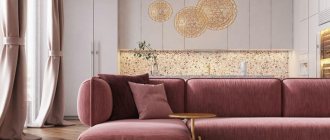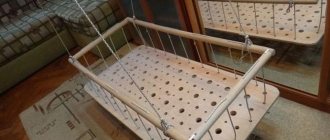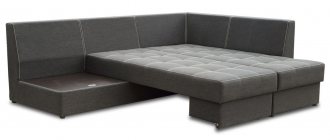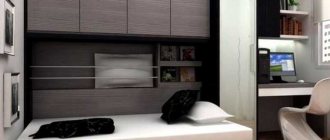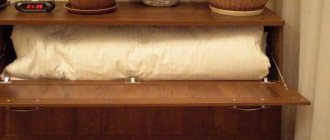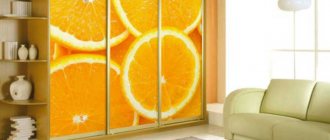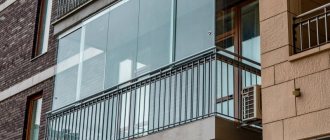Greenhouse design made of arcs with covering material
This device for growing vegetables is characterized by its extremely simple design. It consists of a frame made using metal arcs, covered with a special coating. Most often, polyethylene film or dense non-woven fabric is used for these purposes. The height of the greenhouse is measured by the distance from the ground to the top point of the first arch. Most often it ranges from half a meter to one hundred and thirty centimeters.
Most often, greenhouses are low, fairly compact, but long structures Source it.aviarydecor.com
On average, the width of greenhouses ranges from 0.6 to 1.2 meters. This indicator depends on the height and thickness of the arcs. The length is selected based on the number of arches and the step between them. The most common models are 4.6-8 meters long. Most often, all parameters are standard.
If you plan to order an individual design from a private workshop, then you can develop any project, and it will be completed for a relatively small fee. Just remember, if you choose a greenhouse that is too high, it will be susceptible to overturning by gusts of wind. At the same time, the most unstable are greenhouses with polyvinyl chloride arcs.
A country greenhouse with covering material is not always completely primitive. Often structures are developed with a large number of supports and braces, which simplifies their operation and makes the device more stable and reliable.
Fedorov's greenhouse is a structure with many load-bearing elements Source de.aviarydecor.com
Base made of profiled pipe
To make a greenhouse from profile pipes of rectangular or square cross-section, you will need templates or a pipe bending machine. When making arches , you need to be careful to avoid breaking the axial symmetry and forming dents on the inner wall.
Create with a template
You will need profile pipes, the cross-section of which should be no more than 20 mm.
Manufacturing process:
- According to the length of the arc and the radius of curvature, assemble a pattern from an angle profile, plywood or wood.
- Using clamps, fix one end of the pipe to the pattern. The most convenient way to do this is on a workbench or a specially designated area.
- Holding the other end of the profile element, carefully and slowly bend the pipe into an arc exactly according to the pattern. This may require a lot of effort.
- The bent workpiece must be checked for defects and compared with the template. If there are no defects or they are not serious, then the hand-made part is suitable for the greenhouse frame.
- Make the remaining arcs in the same way.
How to properly prepare a polycarbonate greenhouse for winter
Using a pipe bender
First of all, it is necessary to determine the length of the workpiece and the radius of its curvature. After this you can start working:
- Cut the frame element to the required length from the pipe, place it on the rollers of the machine and make one roll. You must first select a small bend on the machine.
- Insert the workpiece on the other side and roll it again on the rollers. Such rolling is repeated until the curvature of the arc ceases to change.
- The resulting part is checked against the template, and if the required radius has not been achieved, a larger bend is installed on the machine. After this, the pipe is again placed on the rollers and bent until it reaches the desired radius.
The first few arcs will be trial ones. When bending them, it is recommended to mark with a pencil on the jack or adjusting screw the intermediate values of the curvature of the elements.
Scope of application of greenhouses with covering material
Such a device can perform a number of tasks, depending on its size and design. Let's figure out what you can use it for:
- In some areas, the temperature regime does not allow the cultivation of certain plant varieties. In this case, greenhouses with covering material come to the rescue, making it possible to cultivate heat-loving species in any natural zone. Care should be taken to ensure that adult plants can fit inside the structure. In this case, the film is fixed with special fittings designed to allow you to quickly disassemble the entire system and get to the beds.
- Another function of such greenhouses is the adaptation of seedlings to external conditions. The fact is that it cannot be immediately planted in open ground, but it must be given time to harden. If you buy covering material for a greenhouse with the right characteristics, then even very young seedlings will not be afraid of night frosts and sudden temperature changes. Also, good material will protect the beds from ultraviolet radiation, which has a detrimental effect on plants. After all crops have acclimatized, the greenhouse can be removed without damaging the seedlings.
When the weather becomes warmer, the polyethylene can be rolled up Source yard.hozvo.ru
- In the spring-winter period, the soil is not yet warm enough to sow even the most unpretentious crops. But under the protection of a greenhouse, you can always grow radishes or herbs for yourself.
- Even the simplest structures with an arched frame are often used by gardeners to stimulate seed germination. When planting carrots, the first shoots appear no earlier than after 25 days. Greenhouses significantly reduce this period. On average, seeds germinate three times faster under polyethylene.
- Arched structures with film coating help protect beds from mass destruction by harmful insects. After the threat disappears, it will be possible to quickly and easily dismantle the entire structure and remove it from the garden.
- In addition, greenhouses can protect your beds from birds and animals. They are most often used for these purposes during the strawberry harvest, when birds cause enormous damage by pecking at the berries one after another. Any covering can create an obstacle for them, which will protect the plants.
No pests will get inside such a structure Source grand-master.org
See also: https://m-strana.ru/brands/montazh-kaminov-i-pechey/
It is worth noting that the installation of such a structure requires a short period of time. You can assemble it in just half an hour. Any manufacturer must include in the kit the pegs necessary to stretch the greenhouse by attaching frame elements to them. The film or material itself is fixed using clamps, which should also be included in the kit.
But it is possible to purchase a greenhouse, the frame of which is firmly fixed to the canvas in advance. This solution makes the assembly and installation process even simpler and clearer. You just need to unroll the material in the garden bed and stick the bases of the arcs into the ground.
The optimal distance between the arcs of a polycarbonate greenhouse
A frame made of a closed rectangular profile can withstand snow, rain and wind, but its cross-section must be 25x25 mm or 30x30 mm. For the stability of the structure, it is necessary to pay attention to the thickness of the profile wall; it should be 1.5 mm or more. The metal profile itself must be made by cold-rolling, as it will be resistant to corrosion. A greenhouse is a special place where there is high humidity; if you use iron profiles without galvanized coating and made by hot-rolling, they will simply become covered with rust in a couple of weeks. In order to avoid these problems, due to the lack of a high-quality profile, an ordinary iron profile must be coated with a paint and varnish material. Powder-polymer paint is well suited for field conditions; it is resistant to damage such as scratches and chips.
Particular attention should be paid to the distance between the greenhouse arcs. To distribute the load on the entire structure with polycarbonate covering material, the arcs are located at a distance of no more than 1 meter from each other. You can also take into account that the more often the arcs are placed, the stronger the frame for the greenhouse will be. Also, the arches must be solid, not disassembled; if they are disassembled, this reduces the strength of the structure. If the greenhouse frame has a large number of horizontal jumpers (additional steel connecting elements), then this also reduces the strength of the structure due to stress concentration; such a structure is not reinforced.
The polycarbonate covering material must be 4 mm thick with a density of at least 700 g/m2.
The density of polycarbonate is very important, because the higher the density, the greater the load the polycarbonate can withstand, and most importantly, the higher its thermal insulation characteristics will be. Also, polycarbonate must have a fire certificate and UV protection.
UV protection is necessary for polycarbonate because it:
- Vulnerable when exposed to sunlight;
- Its structure changes;
- Properties are lost;
- Further it becomes fragile;
- May crack from simple rain or hail.
When assembling a greenhouse, you need to take into account its ventilation or partial dismantling. If ventilation is done in a greenhouse, then vents are made at the top or on its roof, this helps ensure that clean and cool air is mixed and compared with the temperature in the greenhouse. If you install the vents at the bottom of the greenhouse, then the warm air will remain at the top, and the cold air will not mix, but freeze the seedlings. However, a greenhouse is mostly needed seasonally, during spring, when the snow has just melted, and as a rule, structures are made that can be disassembled and allow the plant to grow in open ground.
Types of metal arcs for greenhouses
The number and type of elements included in the kit depend on the size and purpose of the particular greenhouse. But all the components are sold separately in stores, which makes it possible to extend or adapt a ready-made greenhouse made of covering material for any purpose. Also, if you are thinking about buying a greenhouse, it is better to first compare the prices of individual elements and the entire set. You may find that you save money by putting the kit together yourself.
You can always increase or decrease the number of arcs in such a design Source specagro.in.ua
Before you buy additional items, you should think about what type they should be. So, let's find out what arcs for greenhouses are:
- There are arches made of tight and durable wire covered with a sheath of polyvinyl chloride. Such elements are reliably protected not only from corrosion, but also from various mechanical damage.
- There is an option using steel tubes with a diameter of 10-12 mm, also covered with a PVC sheath. Such elements are characterized by increased rigidity and stability.
- There are also cheaper frame elements consisting of plastic tubes with a cross-section of 20-30mm. But they are less reliable and durable, and often break due to gusts of wind.
This frame made of metal tubes with a PVC shell is durable Source pinkandposh.net
See also: https://m-strana.ru/plots/
To select the most suitable materials and components for a given case, you need to pay attention to their characteristics and operating features. This is a necessary condition in order to make the right decision.
Metal has the greatest strength of all options. An instant greenhouse with steel arcs can be called the easiest to operate and the most reliable. The fact is that any metal is very easily stuck into the ground to a sufficient depth. Increased rigidity and resistance to any impact will prevent the frame from deforming. And the polyvinyl chloride coating will prevent the harmful effects of moisture on metal parts.
Steel greenhouses are more practical Source polikplast.ru
The final price of the greenhouse largely depends on the strength and quality of the materials. Plastic frames always cost much less than steel frames.
The advantages of plastic arches include the fact that they are highly flexible. With this quality, you can always give any shape to the structure, because you will have the opportunity to manipulate the width, height and radius of curvature. But you need to make all adjustments with extreme care so as not to break the tubes when bending. The disadvantage of plastic is that it is quite difficult to stick it into the ground, so you just need to use additional pegs. You can also strengthen such a frame using reinforcement and thick wire.
Plastic arcs for a greenhouse should be bent very carefully Source fermerslife.ru
To fasten the covering material to the frame, plastic or metal clips are used. They can always be found in hardware stores, and if you add extra accessories to your greenhouse, this will only benefit it. To fix the coating to the ground, pegs with clamps are sold. They must be used so that the wind does not undermine the canvas.
With your own hands
If it is not possible to purchase a ready-made greenhouse made of arcs with covering material, you can make it yourself. The greenhouse consists of a frame and cover. Let's consider options for making a greenhouse with your own hands.
The arcs that make up the frame are the main part that serves as the basis. Any covering material can be placed on this base, which can be replaced as necessary. There are several options for making arcs:
- — From a hose and wire (or willow twigs). An old hose that is not used for its intended purpose is cut into blanks into which metal wire or willow rods are inserted. Each piece is then given an arched shape. The arcs are stuck into the ground along the length of the bed at a distance of 50-60 cm from each other.
- — From plastic pipes. The basis for the arcs are metal pins stuck into the ground along the length of the bed. Bent pipes are put on them. The length of the pipe sections depends on the desired height of the greenhouse. But it is not recommended to make sections more than 3 m in length - a greenhouse of such a height will be unstable and it will be inconvenient to care for plants in it. To strengthen this design, you can screw an additional pipe on top using wire.
- — From PVC pipes. For such a greenhouse, it is necessary to make a frame from wooden boards, to which bent sections of pipes are attached. With this design, the pipe material does not stick into the ground and does not corrode.
- - Made of metal profile. Such a frame is strong and stable, but to manufacture it you will need special equipment - a pipe bender. Using this device, the pipes are given the desired shape. Since the greenhouse requires a small diameter pipe, a manual pipe bender can handle this task.
You can see several easy-to-assemble greenhouses made from arcs with covering material in this video:
You can see other greenhouses that you can also assemble or make with your own hands here: From polycarbonate, From window frames, For seedlings, From a profile pipe, From plastic bottles, For cucumbers, Under film, For the dacha, From PVC, Winter greenhouse, Wonderful dacha , Successful harvest, Snowdrop, Snail, Dayas
Different types of greenhouses and their prices
In addition to the individual components for constructing a greenhouse, you can also purchase a ready-made kit with the required number of parts and elements. In stores you can buy greenhouses made of non-woven material and greenhouses with polyethylene coating. This option will help you get rid of unnecessary worries about selecting and purchasing individual parts of the structure. The type of kit and the number of parts in it depends primarily on the area on which you are going to deploy this device.
This is what a kit for assembling a greenhouse with a plastic frame looks like Source orgtorg.org
Please note that factory greenhouses do not require any additional measures for their installation, because the kit already includes all the elements necessary for this. But there is one problem: it will be almost impossible to improve the finished product, so you should choose in advance a design that fully meets your requirements. This is especially true for greenhouses with a combined frame and canvas. Let's look at the different types of greenhouses so that you can choose the one that suits you best.
Pros and cons of designs
Greenhouses made from arcs are convenient due to their mobility and ease of installation.
Installation does not require the construction of a foundation .
For the winter, such a greenhouse can be easily stored when folded, which means it saves storage space.
In addition, they are quite cheap compared to expensive stationary greenhouses.
However, the greenhouse also has a number of disadvantages:
- — The external insulating coating is not durable enough and requires regular updating.
- “For all the lightness of the structure, it can just as easily move under the influence of strong winds.
- — Additional heating cannot be installed in a greenhouse, as in a stationary greenhouse.
Video description
This video contains all the basic information about the Dayas greenhouse
Greenhouse "Agronomist"
This greenhouse is also simple and similar in many respects to the previous model. The frame is also made of metal tubes coated with polyvinyl chloride. For installation, the kit also includes pegs, 20 cm long.
The agronomist greenhouse is very easy to install on any soil, thanks to its metal frame Source cs.aviarydecor.com
The height of the Agronomist is not much greater than the Dayasa. Most manufacturers make such arcs so that the entire structure is 0.9 meters from the ground. But you can adjust this parameter by manipulating the arches. The use of a sectional design allows you to adjust the length of the greenhouse. Standard kits include materials for building a 4 or 6 meter greenhouse, and they cost from 800 to 1000 rubles.
To create such a greenhouse, high-quality and durable Agrotex 42 fabric is used. It has proven itself well and has received recognition from gardeners throughout Russia. If you are going to lengthen the structure, then you can buy this kind of covering material for a greenhouse, the price of which is notable for its affordable price.
“A successful harvest”
The “Successful Harvest” greenhouse is available for sale in three versions: 4 m with five arcs, 6 m with seven arcs and 8 m with nine arcs. This design is completed with covering material. Modern non-woven thermally bonded fabric with a density of 40 g/m² reliably protects both seedlings and already grown plants from excessive exposure to sunlight and moisture. UV stabilizers guarantee the strength and durability of such covering material. Its service life is at least three years.
The greenhouse for cucumbers “Successful Harvest” is also equipped with durable plastic arches. They are made from pipes with a diameter of 20 mm. The width of each of them is 120 cm, height – 80 cm. These sizes are ideal for growing cucumbers in greenhouses, as well as other vegetable crops.
The main advantage of structures of this type is low cost. Greenhouses “Successful Harvest” are equipped only with covering material and arcs. The absence of other parts allows our company to sell them at an affordable price. Such a successful offer has already been appreciated by gardeners and gardeners. By the way, it is also beneficial that you do not have to replace the covering material every year. This cucumber greenhouse will last you at least three years with proper use and storage.
Technologies for the production of greenhouses from arcs with covering material
The construction of a greenhouse has its own subtleties and secrets of mastery. The most difficult thing is to make the correct arches and securely attach the canvas to them. To make arcs, tubes with a diameter of 20-25 mm made of plastic or metal are purchased. Also, for these purposes, many use steel wire with a cross-section of 10 mm. There are also possible options for a frame made from irrigation hoses with threaded rods.
Such a greenhouse made of plastic tubes does not take up much space, but can provide you with herbs or radishes Source otomate.ru
Before you start creating a greenhouse, be sure to determine the dimensions of the future product. The width and length depend on the available space, but the height of the arch will be influenced by what plants you are going to plant in the greenhouse.
Next, a wooden box is made from a board or timber, which will be the basis for the entire structure. Most often its height is 15-20cm. The size of such a foundation must correspond to the size of the bed that is planned to be covered with a greenhouse. The species most resistant to fungal diseases, such as larch or oak, are best suited for creating a wooden base. Then the finished box is placed in the place where it will perform its functions.
A rafter board base is perfect for any greenhouse Source bayanay.info
Manufacturing of metal structures
Choosing a metal version of the frame, of course, will have to work hard, but it is stronger and more reliable. You will need a welding machine and the ability to use it. Due to the strength of the metal, bending a rod into an arc is not easy. More often they cut it in half in order to secure it by welding and bend it at the desired angle.
Greenhouse frame made of metal arcs
The algorithm of actions is as follows:
- Place the base of the frame: lay a corner or square around the perimeter, connecting it together by welding. If there is a foundation, pins or other fasteners are left in the latter, to which the base should be connected.
- There will be a long rod running along the top of the greenhouse in the middle (along). Initially, it can be strengthened using two vertical profiles located on two different sides.
- Weld pieces of corners or crosses into the places where the arcs are installed on the base. Make similar blanks on the top crossbar. Step – 50 cm. Make sure that they are evenly spaced.
- Weld each rod at the bottom to the workpiece. Bend it, attach it to the top crossbar.
- Using a similar principle, mount the rod on the second side.
- Construct all the arcs in the same way.
- On the pediment, install vertical posts from a profile or corner, which will become a frame for the door. Attach loops to them.
- Weld a door from the corner. Hang it on the hinges.
- If it is necessary to make vents, the principle of their installation coincides with the installation of the door.
Greenhouse made of metal arcs
Attention! The metal gets very hot from the sun and has an additional negative effect on polyethylene, reducing its service life. The heat insulator can be a light fabric wound around the arc. You will not encounter a similar problem if you choose the option of making arches made of plastic.
Greenhouse installation Snowdrop
The snowdrop greenhouse package includes the following elements:
- Canvas made from eco-friendly material used to cover arches.
- Arcs made of plastic, used as a frame for covering material, with a diameter of two centimeters.
- Plastic pegs for securing the structure in the ground - fifteen pieces, twenty centimeters long.
- Plastic clips used to fix the covering material on the arches - fifteen pieces, with a diameter of two centimeters.
- Instructions with tips for installing a greenhouse.
A good help in assembling this structure is that the material that is used to cover it is immediately supplied assembled, that is, it is already stretched over the arcs. In fact, all that remains is to find a suitable place on the site and you can fix the Snowdrop greenhouse on it.
The installation of the structure can be divided into several steps:
Step 1. First you need to take the greenhouse out of the packaging and straighten it, allowing the folds to even out. Unfold the canvas along its entire length.
Step 2. You need to determine the location where the Snowdrop greenhouse will be installed. Here it is important to pay attention to where the beds are located on the site and how they are oriented; traditionally it is considered correct to install a greenhouse (as well as beds) from the south to the north. In this case, the crops growing in the greenhouse are heated in the cool morning by the sun's rays and in the evening they also receive the soft illumination of the pre-sunset sun.
Step 3 . After choosing the place where the greenhouse will be installed, you need to stick the pegs into the arcs. The latter must be carefully inserted into the ground, burying the sharp part of the pegs into the ground.
Step 4 . Now you need to secure the covering material to the arches using special clips, which are included in the Snowdrop greenhouse kit. It is these clips that allow the covering material to be opened slightly, thereby ensuring air access to the structure.
Step 5. Lastly, you need to tie the edges of the greenhouse.
In order for the Snowdrop greenhouse installed on the site to stand firmly on the ground, you should pay attention to a number of tips. For example, to strengthen the end sides, knots should be tied on them. After which they are pulled at an angle and fixed with any stick. Also, one side of the greenhouse should be left untouched; crops will be watered and the greenhouse will be ventilated through it. And the other side of the greenhouse needs to be pressed to the ground with a heavy object or just a large stone. It makes sense to place several five-liter bottles of water inside the Snowdrop greenhouse without closing the lids on them. These containers will absorb heat during the day, and at night gradually release it to the surrounding space, thereby maintaining the desired temperature inside the greenhouse.
So, now you know how to install a Snowdrop on your summer cottage. In the end, we note that this is a fairly durable design that is easy to install yourself, quite functional and easy to use. Its main advantage is the possibility of ventilation by lifting part of the covering material. In addition, the material used to cover this type of greenhouse allows the heat of the sun's rays to pass through, but at the same time prevents burns. This fact is especially important in spring, when the plants have very delicate foliage and the sun's rays are already very hot.
See also video:

